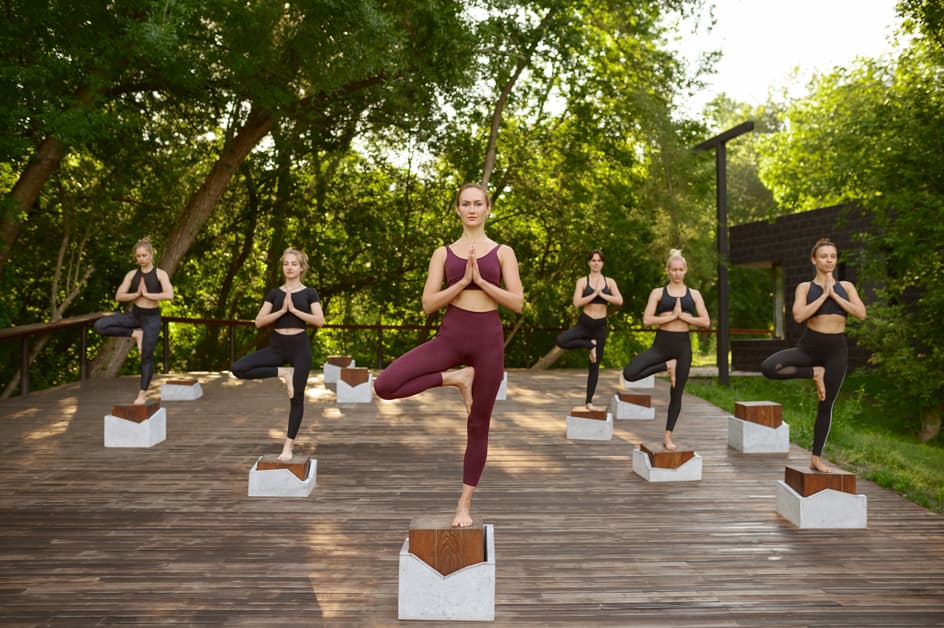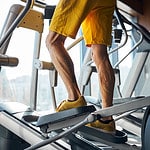Introduction
Balance is key to moving efficiently while cycling. Poor balance, flexibility, and strength in the lower limbs can cause knee pain or injuries. To avoid this, include balance exercises in your routine! Such exercises will improve biomechanics, posture, and cycling performance.
Examples of balance exercises:
- squats
- lunges
- one-legged balance drills
- planks
This will help reduce the risk of developing or aggravating existing knee pain or injuries.
Benefits of Balance Training
Balance training is a must for cyclists! It helps prevent knee pain and strengthens leg and core muscles. This makes it easier to control your bike and reduces pain. Plus, it helps use different muscle groups and coordinate your pedaling more efficiently.
Let’s explore the benefits of balance training for cyclists:
Improved muscular balance
Balance training has a variety of health rewards. It helps athletes control and maintain their movements better. Muscles which are in balance contract more powerfully, leading to greater strength and power, and helping to lower the risk of injuries. Here are how regular balance training can help muscle balance:
- A strengthened core. Balance training engages the core muscles, for instance the abs and back muscles, to hold your body steady during exercise. This builds a robust core, increasing stability for other workouts like running or weight lifting.
- Improved stability. By testing your body’s ability to stay in balance on different surfaces or positions, you are strengthening stabilizer muscles that aid controlled movement patterns. This reduces the danger of injury, by making sure all muscles work together effectively for activities such as jogging or biking.
- Enhanced posture. Good posture is necessary to avoid pain or injury due to bad alignment or poor habits like slouching. Balance exercises work on the postural musculature, supporting correct spinal alignment even when seated or doing everyday tasks like lifting items off shelves or carrying groceries up stairs.
- Increased flexibility. Balance training involves stretching into different ranges of motion while stabilizing in a certain position. This is great for improving flexibility and reducing stiffness in tight joints like ankles, hips and shoulders, which people often get from spending too much time sitting without taking regular breaks for movement or stretching.
Improved neuromuscular control
Balance training is exercise that boosts neuromuscular control, coordination, strength, and stability. It can stop injuries and aid daily activities. Balance training can also restore lost skills, helping those with muscle and joint impairments.
This exercise enhances agility, allowing movement with balance and stability. It helps an individual respond quickly and efficiently. Plus, it increases proprioception, the ability to know your body’s position without external cues.
Reduced risk of injury
Balance training can help cyclists maintain steady and upright positions. This can lower the risk of injury, like ones caused by overuse and bad technique. More stability helps reduce knee strain, tendonitis and other pains.
Exercises like single-leg hops, step ups and lateral jumps can help muscles adapt and work better in tough riding.
Strengthening the stabilizing muscles around the hips is a key for healthy knees. Imbalance in muscle strength can cause pain or discomfort when pedaling for long periods. Squats and lunges can increase hip stability to protect knees from injury.
Balance training can improve movement patterns for good cycling form while also decreasing injury risk from cycling.
Balance Training Exercises
Balance exercises can be beneficial for cyclists! They can help with body stability and reduce the risk of knee pain. To get the most out of the exercises, cyclists should focus on strengthening, stretching and endurance exercises that target the muscles and joints around the knee.
Here are some great exercises for cyclists to reduce their chance of knee pain:
- Strengthening exercises
- Stretching exercises
- Endurance exercises
Single-leg balance
Single-leg balance exercises can help improve your balance and stop knee injury when cycling. Stand on one leg, with the other off the ground. This strengthens the muscles in both legs, especially around the knee joint.
Start slowly and stay in control. Use a chair for stability or get someone to spot you. Here are some exercises:
- Single-Leg Balance: Stand on one foot. Point your toes forward and keep hips neutral. Hold for 30 seconds. Switch legs.
- Single Leg Balance Reach: With one foot up, reach down with opposite hand. Keep hip and back straight. Repeat 10x each side.
- Selective Core Activation during Single Leg Balance: Stand on 1 leg. Rotate upper body from side-to-side for 10 seconds. Rest for 5 seconds. Repeat 4 times each side.
- Dynamic Balance Training: Lightly hop from 1 foot to the other for 30 seconds. Control the body without “jiggling” or “shaking“. Rest for 10 seconds. Repeat 3 times.
Single-leg hops
Single-leg hops are great for coordination, stability, and reaction times. Find a flat surface, like grass or a mat, to do the exercise.
- Stand on one foot. Bend your knee slightly and have the other leg out in front. Your arms should be in an L shape.
- Hop on one leg and catch the other foot before it touches the ground. Don’t jump too high – otherwise it’s hard to catch!
Do 3 sets of 10 reps each leg. Rest for 30 seconds between sets. This is key for balance training.
Single-leg squats
Single-leg squats are an important balance exercise for cyclists. Stand on one leg, and lower the other one like you’re about to sit on a chair. Balance with your arms out. Doing this builds your legs, boosts coordination, and helps core stability. It also reduces knee stress.
Single-leg squats make pedaling more efficient, as they stabilize the knee and increase hip flexion. They also strengthen the tibialis anterior muscle, which helps resist external forces while cycling. Do it right and it’ll reduce the chance of chronic knee pain or injury caused by cycling.
Incorporating Balance Training into Your Cycling Routine
Balance training is a must for your cycling routine! It helps reduce knee pain and increase performance. Joint stability, coordination, and proprioception will all benefit. This can help lower the risk of injury and boost performance.
So, how can you integrate balance training into your cycling routine?
Warm up with balance exercises
Balance exercises are a must for cyclists’ warm up! Not only do they strengthen and coordinate muscles, but also help improve focus.
Here’s how to do it:
- Stand on one leg, with the other foot in front of you. Hold it for 20-30 seconds, then switch.
- Another exercise is a single leg deadlift. Start by standing with both feet hip-width apart and balancing on your right foot. Lean forward, extending your left leg behind you. Reach towards the floor with a slight bend in your right knee, keeping your core engaged while returning to the start position. 10 reps each side.
Incorporating balance training as part of your warm up will increase muscle strength and coordination. And, it’ll help you be aware of your body during the ride, maximizing efficiency and preventing injury.
Incorporate balance exercises into your rest days
Balance is a must for an effective cycling training routine. It is even more important than strength. Strength training is great for leg muscles, but balance strengthens your core, increases stability, and prevents injury. Put balance exercises in your rest days for better balance in and out of the bike.
Here are some ideas:
- Single Leg Stance – This exercise works proprioception. Stand, then lift one foot off the ground and hold it for 30 seconds or more. For a more intense activity, close your eyes or move your arms while balancing on one foot.
- Bridge – Lie face-up on the ground. Feet flat, knees bent. Heels together, press feet into the floor. Raise hips to the ceiling, forming a straight line from chest to knees. Hold. Lift one arm and one leg at a time. Return to starting position, then lower hips.
- Single Leg Squats – This requires strength too. Stand with feet hip-width apart. Lift left leg slightly (not higher than knee level). Push hips back, bend left knee until thigh is parallel to floor. Return, hold for 30 seconds.
- Walking Planks – Get into plank position (on hands and toes). Alternate legs. Step forward with one foot, followed by the other. Keep torso stable throughout. Hold for 3-5 seconds, alternating legs. Complete 1 set of 10 alternating steps.
These exercises will make balancing on and off the bike much easier!
Use balance exercises as a cool down
Balance exercises are a great way to end a cycling session. They can help reduce muscle soreness, prevent inflammation, and improve your ability to stay steady on the bike. But remember, it’s a cool-down – not a cardio workout!
Options include:
- Single leg balances
- Tandem stances
- One leg hopping
- Walking/pivoting drills
- Eye tracking drills
- Ball control
Try 10 seconds per exercise, 3 sets each, for a total of 30 seconds. Then, be sure to stretch for optimal recovery.
Conclusion
So, to avoid knee pain, you can make small changes to your cycling routine. Balance training exercises like resistance bands and stretching can help. Adjust your bike setup and posture, too. Pay attention to any symptoms or signs of discomfort while cycling – it can prevent a major issue tomorrow. Staying balanced and properly trained is the best way to cycle long distances without injury or imbalanced muscles.
Frequently Asked Questions
Q: What is balance training?
A: Balance training is an exercise program that focuses on strengthening the muscles and improving coordination to help improve balance.
Q: How can balance training help with knee pain?
A: Balance training helps to increase the strength of the muscles around the knee joint, which can help to reduce the risk of knee pain due to overuse or weak muscles.
Q: What types of exercises can I do for balance training?
A: There are a variety of exercises that can be done for balance training, such as single-leg stands, one-legged squats, and lateral jumps. Additionally, using a balance board or Bosu ball can help to improve balance while cycling.





